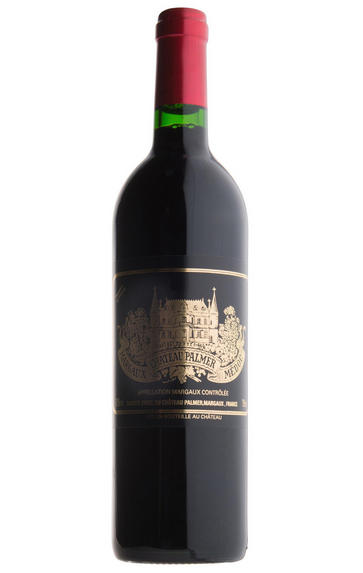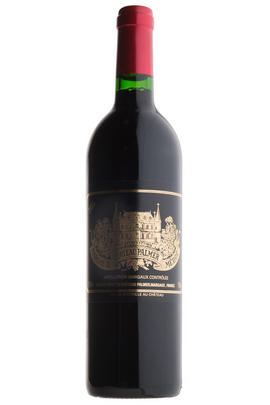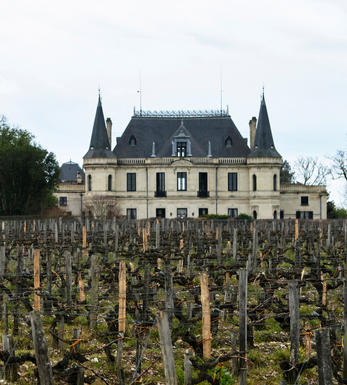
2018 Château Palmer, Margaux, Bordeaux

Critics reviews
A year that has already passed into Palmer legend. An extremely stressful growing season, where mildew brought the yield right down to 11hl/h, and no Alter Ego was produced. What the team produced with the rest is therefore even more extraordinary. No question that this is concentrated and muscular, and needs time in bottle, but even at this early stage the richness and depth of display are clear.
Cabernet Sauvignon dominant, cassis and damson fruits studded with chocolate shavings, grilled cedar, slate and gunsmoke, all delivered with precision and laser impact. The violet and peony florals are Palmer are there, but they just give a hint of themselves right now, highlighting the depths that are to come with this wine over time. A standout success. 79% new oak. Bottled July 2020, after one year in barrel, second year in larger-sized Stockinger barrels for 20% of the crop to soften oak influence.
Drink 2028 - 2048
Jane Anson, JaneAnson.com (September 2021)
The 2018 Palmer is a legend in the making. I had an inkling out of barrel, but such was the intensity that I wanted to assess it in bottle before I felt confident in saying so because this could have gone either way. It storms from the glass with black fruit and floral scents, crushed violet and incense that knock your senses sideways while retaining brilliant delineation and focus.
The palate is not quite as bold and brassy as when I tasted it from barrel, though I can vouchsafe that among over 20 vintages of Palmer that I have tasted at this stage, this is easily the most extroverted and powerful, displaying a kind of millefeuille of intense black fruit counterpoised by a razor-sharp line of acidity.
This audacious Palmer was still revving its engines 48 hours after opening. There will never be another Palmer like this, sui generis. It was a massive risk. But by throwing caution to the wind, something extraordinary was born.
Drink 2030 - 2070
Neal Martin, Vinous.com (March 2021)
The 2018 Palmer is even more impressive from bottle than it was from barrel, and that is saying something. Palmer is a real head-turner in 2018, rich, exotic, and beautifully layered. Inky dark fruit, chocolate, liquorice, espresso and sweet floral notes build over time, but the wine's stunning depth and textural voluptuousness elevate it into the realm of the truly sublime.
As I wrote in my initial review, the 2018 Palmer is a freak of nature from yields of just 11 hectoliters per hectare harvested over an entire month. Mildew was especially punishing. There is no Alter Ego, just the Grand Vin. Kudos to CEO Thomas Duroux and his team for what I can only describe as a truly magical wine.
Drink 2033 - 2068
Antonio Galloni, Vinous.com (March 2021)
Analytically the most powerful Palmer ever in terms of the tannins and the alcohol. Thanks to mildew, their yields were a measly 11 hl/ha and the total production was about 6,000 cases. No Alter Ego this year. ‘A wine that will mark the history of the property’, according to technical director Thomas Duroux, like 1961. ‘A miracle from the vintage’, he thinks. 40% Merlot, 53% Cabernet Sauvignon, 7% Petit Verdot. Harvested from 13 September to 15 October. Barrel sample.
Black with barely a purple rim. Intense, concentrated cassis and blackberry, super-ripe but absolutely not overripe, a little bit of alcohol on the nose, lightly floral even with all this concentration. Very dark, almost a little tarry, black olive. Dark and rocky. On the palate, incredible concentration and density but with no thickness or astringency. So dense but so clean-lined and precise. Tannins are dry and compact but smooth and there’s an amazing freshness that seems to come from the compact tannins. And your mouth feels clean on the finish. So moreish even though at the moment you would have to take small sips. Great finesse to the texture even in such a big wine. Dark, dark and savoury on the finish. No sweetness even though the fruit is pure and ripe.
Drink 2028 - 2045
Julia Harding MW, JancisRobinson.com (April 2019)
The 2018 Palmer is composed of 53% Cabernet Sauvignon, 40% Merlot and 7% Petit Verdot. The wine has a 3.83 pH and 14.3% alcohol.
Very deep garnet-purple in colour, it explodes from the glass with atomic scents of blackberry preserves, crème de cassis and blueberry pie, plus suggestions of red roses, clove oil, dark chocolate and cedar chest with hints of Chinese five spice and menthol. The full-bodied palate is decadently styled, offering layer upon layer of black fruit preserves and exotic spices, framed by exquisitely plush tannins and seamless freshness, finishing wonderfully fragrant and with epic length. It's an amazingly beautiful beast of a wine—one for the hedonists!
Drink 2023 - 2053
Lisa Perrotti-Brown, Wine Advocate (March 2021)
Complex nose of black cherries, blackberries, dark chocolate and floral undertones with perfume-like character. It’s full-bodied with firm tannins. Elegant on the palate with structure. Savoury and balanced, complex and layered. Long finish. Really lingers. This has really evolved into a beautiful white swan after a difficult debut from barrel! Tiny production. only 11 hectoliters per hectare.
Try after 2024
James Suckling, JamesSuckling.com (February 2022)
While there's not much to go around, the 2018 Château Palmer is unquestionably a stunning bottle of wine. I certainly can't think of another Palmer coming close to this level of concentration (maybe the 2010 comes closest?). This blockbuster boasts a dense purple hue as well as a primordial bouquet of black cherries, mulberries, and blackberries intermixed with freshly crushed rocks, smoke tobacco, gravelly earth, lead pencil shavings, and burning embers. With full-bodied richness, a dense, stacked mid-palate, mouthcoating tannins, and a blockbuster of a finish, it's going to need 10-15 years to hit maturity, and as I wrote last year, will live for just about forever.
Drink 2033 - 2083
Jeb Dunnuck, JebDunnuck.com (November 2021)
About this WINE

Château Palmer
Château Palmer is a leading wine estate in Margaux. Within its appellation, Palmer is certainly the closest rival to its first growth neighbor, Ch. Margaux. Although officially ranked a Third Growth, at their best, the wines of Ch. Palmer are among the greatest anywhere in Bordeaux.
The estate dates to the 17th century, though it was not until 1814 that Englishman Charles Palmer took ownership and gave it his name. In 1938, the estate was bought by four Bordeaux négociant families, two of whom – Sichel and Mähler-Besse – still own the property today. Since 2004, the estate has been led by the charismatic agronomist and oenologist Thomas Duroux, who had previously made wine at Ornellaia in Tuscany.
Thomas undertook major renovations, including completely modernizing the grape reception area, the vat rooms, and barrel cellar. In the vineyards, the technical team began experimenting with biodynamic farming, and today Palmer is among the leading biodynamic vineyards in Bordeaux. In addition to the grand vin, the Ch. Palmer’s portfolio also includes a cuvée called Alter Ego.
Introduced in 1998, Alter Ego is produced from grapes grown on dedicated plots and blended differently from the grand vin. As such, the estate regards it not as a second wine but as a distinctive cuvée in its own right.
Palmer lies in the commune of Cantenac, just outside the village of Margaux. 66 hectares of vines are planted on a plateau of gravel, sand, and clay soils overlooking the Gironde estuary. Plantings include equal parts of Merlot and Cabernet Sauvignon at 47% each and 6% Petit Verdot. Although the average age of the vines is fairly typical of the region at about 40 years, some of the vines are over 70 years old. That, along with the relatively high Merlot content and the benefits of careful, well-established biodynamic practices, may account for the wines’ richness and complexity.
Fermentation occurs in conical, stainless-steel vats in varying sizes, allowing each variety and parcel to be fermented separately for subsequent selection and blending. The grand vin is aged for 20-22 months in barrels, of which less than 50% is new. Thanks to the health and consistency of the estate’s biodynamically produced fruit, Palmer has been able, over the past few years, to safely reduce the quantity of sulfites added throughout the process, aiming to produce wines with more freshness and purity of flavor. For Alter Ego, less new wood is used, and aging time is slightly reduced to produce a wine the estate describes as “distinguished by its freshness of fruit, crisp intensity, and richness from the moment out of the barrel”.
Between 2008 and 2013, Ch. Palmer made the transition to 100% biodynamic farming. In addition to its vineyards, the estate is home to a diversity of complementary plants and grazing animals.

Margaux
If Pauillac can be seen as the bastion of ‘traditional’ Red Bordeaux, then Margaux represents its other facet in producing wines that are among Bordeaux’s most sensual and alluring. It is the largest commune in the Médoc, encompassing the communes of Cantenac, Soussans, Arsac and Labaude, in addition to Margaux itself. Located in the centre of the Haut-Médoc, Margaux is the closest of the important communes to the city of Bordeaux.
The soils in Margaux are the lightest and most gravelly of the Médoc, with some also containing a high percentage of sand. Vineyards located in Cantenac and Margaux make up the core of the appelation with the best vineyard sites being located on well-drained slopes, whose lighter soils give Margaux its deft touch and silky perfumes. Further away from the water, there is a greater clay content and the wines are less dramatically perfumed.
Margaux is the most diffuse of all the Médoc appelations with a reputation for scaling the heights with irreproachable wines such as Ch. Margaux and Ch. Palmer, but also plumbing the depths, with too many other châteaux not fulfilling their potential. There has been an upward shift in recent years, but the appellation cannot yet boast the reliability of St Julien. However, the finest Margaux are exquisitely perfumed and models of refinement and subtlety which have few parallels in Bordeaux.
Recommended Châteaux: Ch. Margaux, Ch. Palmer, Ch. Brane-Cantenac, Ch. Rauzan-Ségla , Ch. Dufort-Vivens, Ch. Ferrière, Ch. du Tertre, Ch. Giscours, Ch. d'Angludet.

Cabernet Sauvignon Blend
Cabernet Sauvignon lends itself particularly well in blends with Merlot. This is actually the archetypal Bordeaux blend, though in different proportions in the sub-regions and sometimes topped up with Cabernet Franc, Malbec, and Petit Verdot.
In the Médoc and Graves the percentage of Cabernet Sauvignon in the blend can range from 95% (Mouton-Rothschild) to as low as 40%. It is particularly suited to the dry, warm, free- draining, gravel-rich soils and is responsible for the redolent cassis characteristics as well as the depth of colour, tannic structure and pronounced acidity of Médoc wines. However 100% Cabernet Sauvignon wines can be slightly hollow-tasting in the middle palate and Merlot with its generous, fleshy fruit flavours acts as a perfect foil by filling in this cavity.
In St-Emilion and Pomerol, the blends are Merlot dominated as Cabernet Sauvignon can struggle to ripen there - when it is included, it adds structure and body to the wine. Sassicaia is the most famous Bordeaux blend in Italy and has spawned many imitations, whereby the blend is now firmly established in the New World and particularly in California and Australia.


Buying options
Add to wishlist
Description
A year that has already passed into Palmer legend. An extremely stressful growing season, where mildew brought the yield right down to 11hl/h, and no Alter Ego was produced. What the team produced with the rest is therefore even more extraordinary. No question that this is concentrated and muscular, and needs time in bottle, but even at this early stage the richness and depth of display are clear.
Cabernet Sauvignon dominant, cassis and damson fruits studded with chocolate shavings, grilled cedar, slate and gunsmoke, all delivered with precision and laser impact. The violet and peony florals are Palmer are there, but they just give a hint of themselves right now, highlighting the depths that are to come with this wine over time. A standout success. 79% new oak. Bottled July 2020, after one year in barrel, second year in larger-sized Stockinger barrels for 20% of the crop to soften oak influence.
Drink 2028 - 2048
Jane Anson, JaneAnson.com (September 2021)
wine at a glance
Delivery and quality guarantee